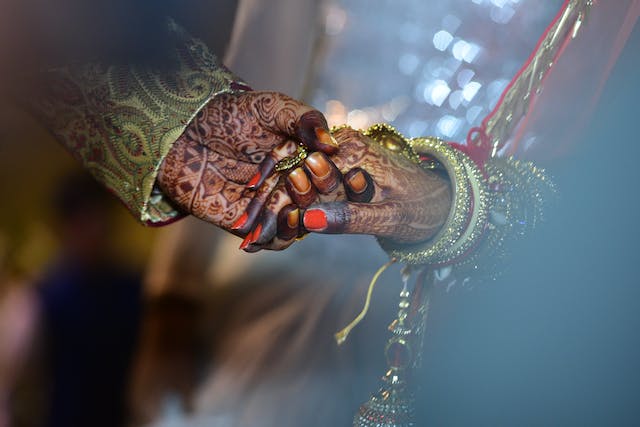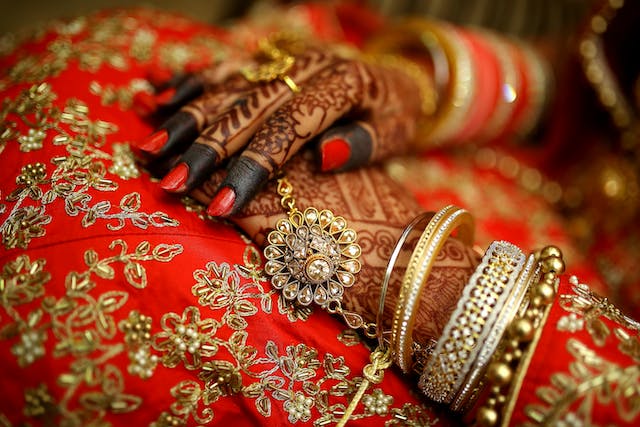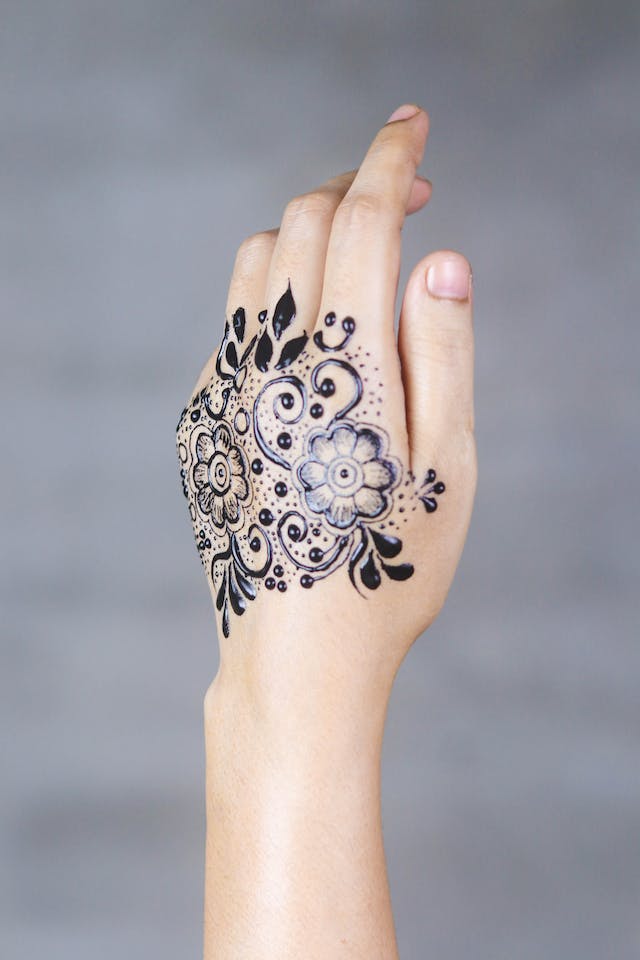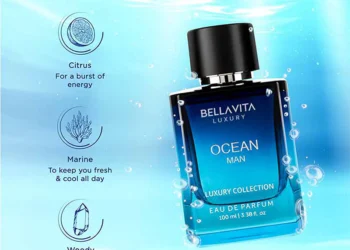History of Mehndi
Mehndi is a widely popular form of body art among brides-to-be. Mehndi design also became part of popular culture, often seen on celebrities . But there’s a fine line between appreciation and cultural appropriation that needs to be carefully treaded when applying mehndi design to bodies.
Mehndi is traditionally applied to brides before weddings or Hindu festivals like Diwali and Karva Chauth, as well as on other special occasions.

Origin
Henna, made from the lawsonia inermis plant, has been used for centuries to adorn skin.
It was initially used for its natural cooling properties in desert regions of Pakistan, India, and Africa where people would apply it on their palms and feet in order to feel cool from the intense heat.
Over time however, more intricate designs began being created using powder instead of paste; hence Mehndi was born!
Meaning
Mehndi, also spelled as “henna,” refers to a natural dye or paste made from the leaves of the henna plant (Lawsonia inermis)
What is Henna
Henna is produced from the powdered leaves of Lawsonia inermis plants and then mixed with water, lemon juice and eucalyptus oil to form a thick paste that is poured into small cones for use overnight to allow its effects to permeate into skin pores.
Popular Types of mehndi design
Mehndi is an amazing body art that holds significant cultural meaning for brides-to-be and is an essential element of every wedding ceremony and looks amazing when combined with traditional clothing.
There are various cultures who have long relied on mehndi design as part of their traditions, so let’s examine some in detail!

Indian mehndi design
- Indian mehndi design are known for their intricate floral patterns symbolizing purity.
- Mehndi originated in Egypt and has become a central part of Indian weddings and celebrations.
- Mehndi paste is made from natural ingredients, often enhanced with sugar or lemon juice for a better experience.
- Personalization is a unique touch in Indian Mehndi, including names or initials within designs.
- The Khafif Mehndi Design combines Indian and Arabic elements for an elegant look.
- Floral motifs and intricate palm designs make Indian Mehndi ideal for special occasions.
Arabic mehndi design
- Arabic mehndi design feature free-flowing, elegant patterns that don’t cover the entire hand.
- Floral elements, curves, curls, and dome-shaped patterns are characteristic of Arabic Mehndi.
- Lotus flowers and leafy patterns in Arabic Mehndi create an elegant bridal look.
- Arches and temple-like motifs add charm and uniqueness to Arabic designs.
- Paisleys, mesh patterns, dot motifs, and flowers combine for eye-catching Mehndi.
- Arabic Mehndi is perfect for brides who want a feminine yet regal appearance.
Moroccan mehndi design
- Moroccan Mehndi blends art, culture, and tradition with geometric and traditional motifs.
- Moroccan designs often mimic the Moroccan landscape, including bustling markets and the Sahara Desert.
- Flower and vine motifs are popular among Moroccan designs.
- Thin lines, glitter, and gems add glamour and simplicity to Moroccan Mehndi.
- Lacy and symmetrical designs are well-suited for special events and look great on both hands.
- Diamond-shaped patterns in Moroccan Mehndi are believed to ward off evil eyes and bring good fortune.
African Henna Designs
- African henna designs are bold, distinct, and rich in geometric symmetry.
- They use linear patterns, angular shapes, and arrays of dots for striking visuals.
- Henna has cultural significance, symbolizing fertility, protection, and luck in weddings and rituals.
- In Sudan, married women wear mehndi on their hands and fingertips, symbolizing kindness and peace.
- Unmarried women may wear mehndi when participating in another woman’s wedding ceremony.
- Mehndi is a temporary body art that typically lasts two to three weeks, using safe, natural ingredients.
10 Most Trending Mehndi Design Ideas

1. Floral Fusion Mehndi
Floral Fusion Mehndi is the latest mehndi design to gain widespread acclaim among girls. This design blends floral and mandala patterns for an eye-catching effect.
Mehndi is an ancient Indian body art with deep cultural significance that can be applied during weddings, festivals, and other celebratory occasions.
2. Minimalist Mehndi
Brides who prefer simpler mehndi design should choose this minimalist mehndi. It features an eye-catching peacock motif accompanied by floral patterns and dots for added charm.
This stunning yet minimal mehndi design only covers the middle finger and thumb of each hand; leaving the remaining portion bare. A unique wrist cuff design adds an eye-catching element for added style.
3. Bridal Glitter Mehndi
Glitter mehndi adds a special sparkle to any mehndi design! Glitter mehndi adds a bold flair that looks gorgeously festive!
Mehndi ceremonies are an integral part of Indian wedding traditions. At a Mehndi Ceremony, bride’s family invites a Henna Artist to decorate the Bride’s hands.
4. Intricate Peacock Mehndi
Brides-to-be looking for something special will love this stunning yet simple backhand mehndi design featuring intricate lattice work on both its tail and arms – sure to leave their wedding day look distinctively memorable!
Add olive oil to your henna paste for a deeper stain, or try essential oils such as lavender, eucalyptus or tea tree oil for best results.
5. Bohemian Mehndi
Bohemian Mehndi ceremonies often serve as second Sangeet events for families celebrating brides before they exchange vows, so check out this fun design that uses vibrant motifs to create a beautiful Rangoli-inspired mehndi design!
6. Mandala Magic Mehndi
Henna symbolizes the cycle of life and universe as well as renewal, hope and strength.
Full-hand mehndi design featuring intricate mandala motifs will only heighten bridal beauty! It creates an amazing and captivating appearance.
This design boasts beautiful leafy patterns connected by an elaborate flower trail from index finger/round base to wrist!
7. Arabic-Inspired Mehndi
This mehndi features intricate flower and leaf designs that look absolutely artistic and magnificent, with dome-shaped design elements and dotted lines giving the impression that this mehndi could pass for bracelets.
8. Contemporary Geometric Mehndi
Contemporary Geometric Mehndi Create an eye-catching bridal look with modern geometric mehndi design! From peacock feathers and paisleys, geometric mehndi can transform your bridal ensemble.
Mehndi symbols hold deep cultural and modern-day interpretations that inspire contemporary creativity. If you want your mehndi design to stand out, incorporate personalized motifs into it to make it truly individual and personalized.
9. Rajasthani Traditional Mehndi
Henna plays an integral part in Indian culture and can be applied for special events like Karva Chauth, Teej and Diwali.
Mehndi styles that feature intricate fine lines are renowned for their exquisite detail. Thin mehndi strokes create intricate designs of horses, Dulha-Dulhans and palanquins which add an air of traditionalism.
10. Moroccan Henna Art
Henna is an intricately colored paste used for temporary tattooing on hands and feet, often seen at weddings and other cultural events as a tradition.
Moroccan traditions tend toward geometric and floral henna designs, also known as Fes or Fassi style henna.
How to Choose a Mehndi Design
Mehndi is a ritual that symbolizes a bride’s purity, helping her feel calm and relaxed before their big day. Cleopatra used mehndi to tint her lips and hair; later it was discovered it has medicinal uses too; its berries contain melanin which has both anti-oxidant and cooling effects – thus providing another use for mehndi!
Looking for a mehndi artist that offers various designs and styles can help ensure that the final outcome fits with both your personality and preferences.
After selecting four to five mehndi artists, organize face-to-face interactions. This is essential in order to evaluate their style and finesse. Each specialist may also have a mehndi design portfolio which showcases their best recent work; perusing it will provide further insight into their area of expertise.
Minimalism and mehndi rarely intersect, but this asymmetric design comes close. The right hand features the Om symbol to symbolize spirituality while the left features intricate lines symbolizing love and commitment – bride Victoria even hidden her groom’s name within this design for their San Francisco nuptials!
When choosing a mehndi design, take care in considering its placement and size. Also keep your time required for application in mind as well as any possible additional expenses associated with complex patterns that take longer to draw or may cost more.
Mehndi Aftercare Tips
Aftercare of mehndi application is essential for achieving an authentic, dark natural henna stain. Although 50% of its color depends on your artist (so make sure they use natural cones without black ink), 50% also depends on you! What follows after an appointment will make a big difference!
One easy step to achieving a deeper henna stain is applying lemon and sugar after it dries – this simple technique should produce even and vibrant colours! Results may differ based on skin tone and body chemistry but this step should ensure an even and vibrant colouring experience.
Additionally, keeping your design hydrated with natural oils such as those found in henna balm or making your own at home also helps. Keep reading for more tips to make sure your henna remains beautiful!
Final Words
No matter your occasion – be it planning your own wedding, attending another’s big event, or just wanting something new – mehndi is an easy and fun way to express yourself and add an elegant and chic look. Use our tips and techniques here in this article to create stunning designs that will leave everyone gasping with admiration.
Frequently Asked Questions
1. What is the history of Mehndi?
Mehndi has a rich history and has been used for centuries, originally for its cooling properties in desert regions.
2. What does Mehndi mean?
Mehndi, also known as henna, is a natural dye made from henna plant leaves.
3. What is Henna made from?
Henna is made from powdered henna leaves mixed with water, lemon juice, and eucalyptus oil.
4. What are some popular types of mehndi design?
Indian, Arabic, Moroccan, and African are some popular types of mehndi design.
5. What are some trending mehndi designs right now?
Some trending mehndi designs include “Floral Fusion Mehndi,” “Minimalist Mehndi,” “Bridal Glitter Mehndi,” “Intricate Peacock Mehndi,” and “Arabic-Inspired Mehndi.”







